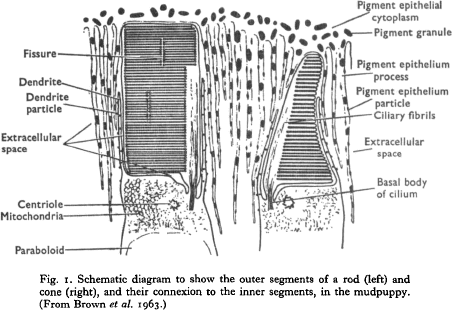It has been known since the time of Schultze (1866) that in the vertebrate retina there are two types of photoreceptors, rods and cones, and that they serve different visual functions; rods for scotopic vision, and cones for photopic. The terminology originates from the shape of the outer segments in which the photosensitive pigment molecules are contained. The cone outer segments are conic and taper towards the tips, while the rod outer segments are typically cylindrical. Fig. 1 is a schematic diagram from Brown, Gibbons & Wald (1963) of the ultrastructure of the rod and cone outer segments of the mudpuppy, Necturus,  as studied by electron microscopy. Both appear to be made up of a pile of transverse paired membranes. In cones these arise by infolding of the plasma membrane, and in rods they have probably arisen in a similar way, but each pair of membranes is sealed around the edge so as to form a closed double-membrane disc (Sjöstrand, 1961). Because of the universal lamellation within the rod and cone outer segments, it looks as if there were no appreciable intracellular space, but yet Toyoda, Nosaki & Tomita (1969), and Toyoda et al. (1970) were successful in intracellular recording from the outer segments of single rods of the nocturnal gecko and frog.
as studied by electron microscopy. Both appear to be made up of a pile of transverse paired membranes. In cones these arise by infolding of the plasma membrane, and in rods they have probably arisen in a similar way, but each pair of membranes is sealed around the edge so as to form a closed double-membrane disc (Sjöstrand, 1961). Because of the universal lamellation within the rod and cone outer segments, it looks as if there were no appreciable intracellular space, but yet Toyoda, Nosaki & Tomita (1969), and Toyoda et al. (1970) were successful in intracellular recording from the outer segments of single rods of the nocturnal gecko and frog.

 as studied by electron microscopy. Both appear to be made up of a pile of transverse paired membranes. In cones these arise by infolding of the plasma membrane, and in rods they have probably arisen in a similar way, but each pair of membranes is sealed around the edge so as to form a closed double-membrane disc (Sjöstrand, 1961). Because of the universal lamellation within the rod and cone outer segments, it looks as if there were no appreciable intracellular space, but yet Toyoda, Nosaki & Tomita (1969), and Toyoda
as studied by electron microscopy. Both appear to be made up of a pile of transverse paired membranes. In cones these arise by infolding of the plasma membrane, and in rods they have probably arisen in a similar way, but each pair of membranes is sealed around the edge so as to form a closed double-membrane disc (Sjöstrand, 1961). Because of the universal lamellation within the rod and cone outer segments, it looks as if there were no appreciable intracellular space, but yet Toyoda, Nosaki & Tomita (1969), and Toyoda